Best gardening gloves in 2025: Tested and rated
We tested a range of products to find the best gardening gloves you can buy
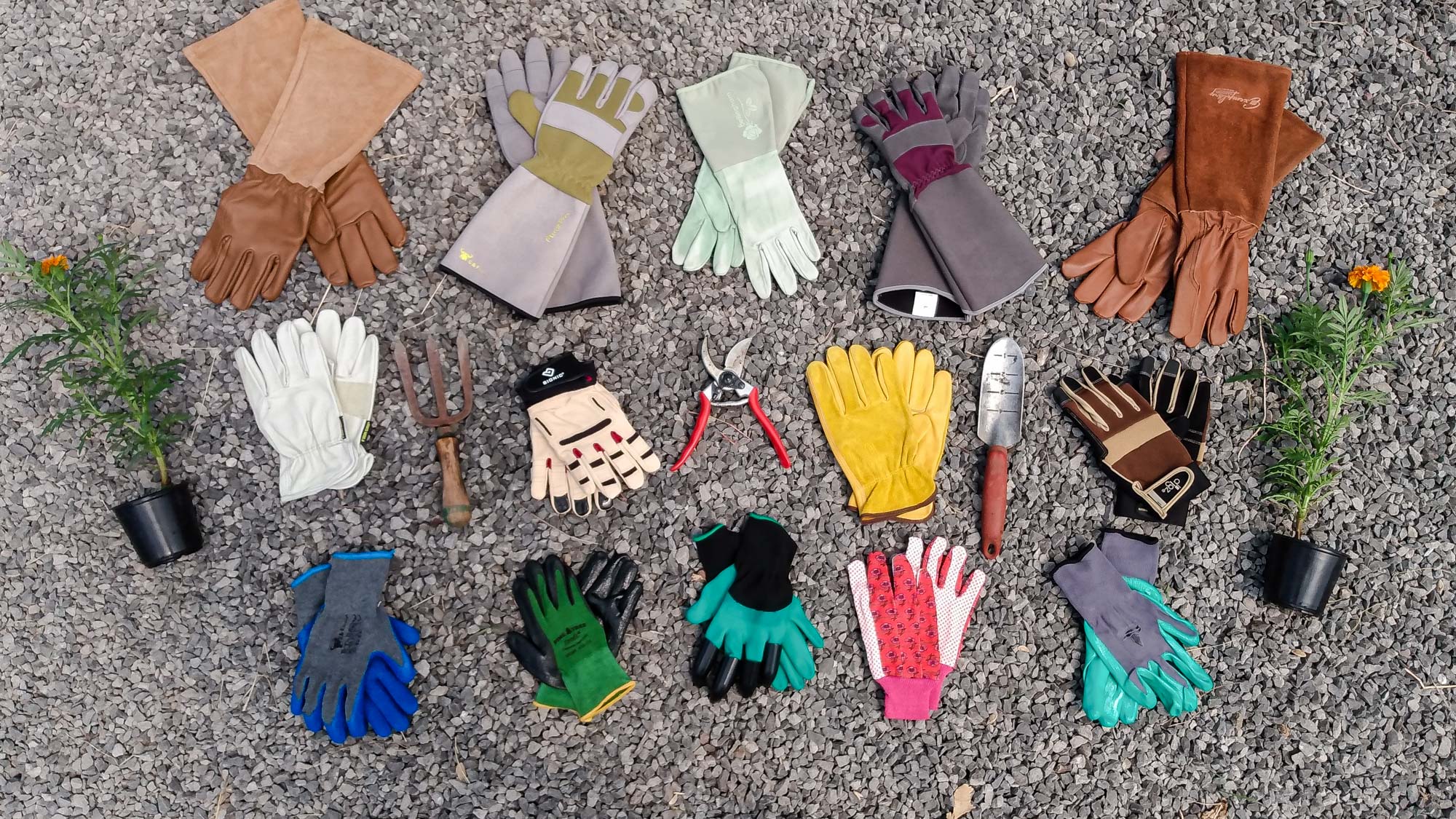
Before I start any job in my garden, no matter how small, I grab hold of my gardening gloves. Apart from keeping my hands clean, dry, and allowing them to breathe, they protect them from cuts, thorns and possible infections. They also give me added grip when I need it, and prevent painful blisters.
For me, choosing the right pair of gardening gloves is just as fundamental as using the correct gardening tools. And, I have several pairs to choose from, depending on the job in hand.
There are plenty of all-purpose gloves available that are good all-rounders, but you might be better off buying gloves designed for heavy work or for tending to delicate seedlings, offering protection or dexterity as required.
I recruited the help of Farmer Rich, a fruit and vegetable farmer, to help me test a range of gardening gloves. After extensive hands-on research, he chose the Amazing Stuff for You nitrile-coated gardening glove as the best overall pick, with G&F’s Rubber Latex Double Coated Work Glove as the best value, while Bionic’s Relief Grip Gardening Glove is the best for comfort.
Take a deep dive into the best gardening gloves you can buy.
The Quick List
Here are the best gardening gloves you can buy right now based on our comprehensive testing. Scroll on for our full in-depth reviews.
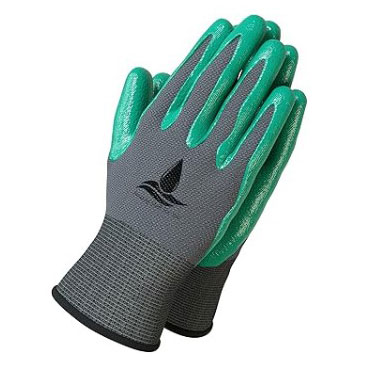
These gardening gloves provide an excellent grip and have a comfortable fit around the wrist, plus they are breathable and machine washable and available in three sizes. They are perfect when you need a medium-duty gloves that provides dexterity. Plus, they come in a pack of two.
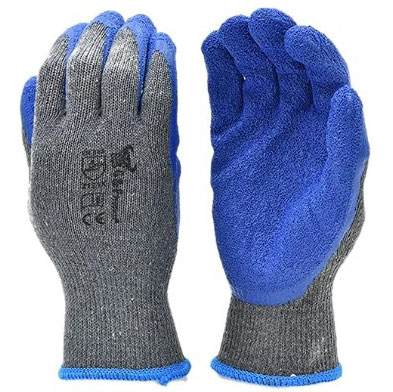
These G&F rubber and latex work gloves offer excellent value per single pair. The heavy-duty gloves has a non-slip texture and comes in four sizes. Plus, you can also use your mobile without removing them. An excellent all round performer and ideal for handing out to use for community projects.
Read more below
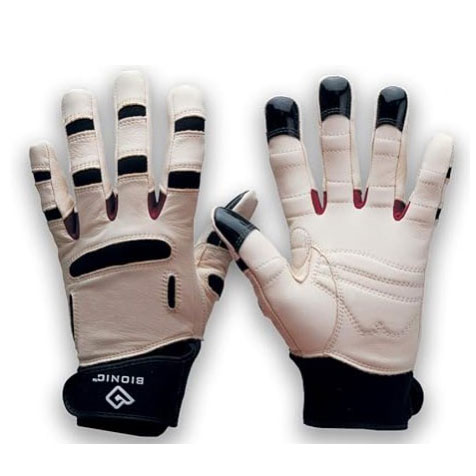
These gardening gloves certainly look professional and are super comfortable too. Made out of goatskin leather, neoprene, lycra and silicon, they are durable and ideal for problem hands. The gloves have special motion zones to ease movement and padding to reduce vibration when using gardening tools.
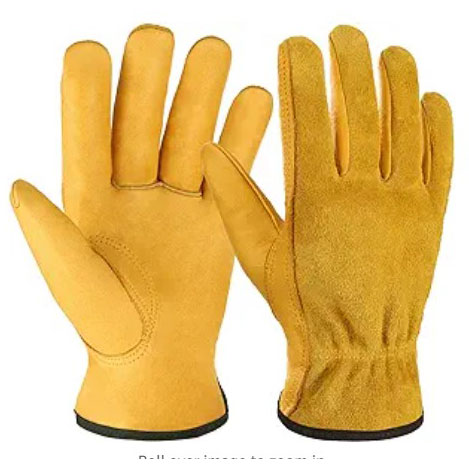
Perfect for heavy-duty gardening tasks, these OZERO leather work gloves also offer a flexible grip. They are puncture and scrape resistant and have double-stitched seams for added durability. They won't win any prizes on the design stakes but they are comfortable and extremely functional.
Read more below
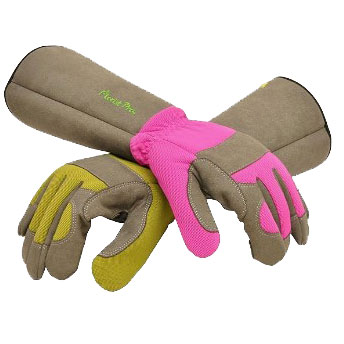
Offering the benefits of a work glove with a protective gauntlet for rose pruning, these G&F gloves are made of synthetic leather. They also provide plenty of protection with a padded palm and reinforced fingertips and offer a good grip even when wet, although the backing is not water-resistant. They are available in a choice of colorways.
Read more below
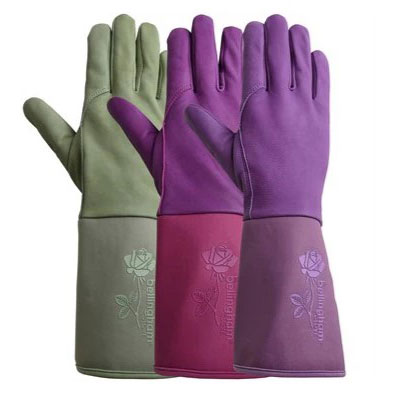
These women's gauntlet pruning gloves are soft and comfortable thanks to the addition of lanolin. They also offer great dexterity when planting, while protecting against thorns when pruning. The gloves are available in pink, sage green and lavender.
Read more below
Meet our experts
Our experts
Why you can trust Tom's Guide

I'm Rich, an experienced farmer and owner of McCollum Orchards, which has been in my family for 200 years. I took on the farm with my wife, Bree, in 2011. Since this time, I've gained vast experience in wearing and testing gardening gloves and am able to put them through rigorous tests to see if they make the grade. Whether I'm tending to my fruit, vegetables and flower farm on my 100-acre organic farm, you'll always find me wearing one of the best pairs of gardening gloves.

I'm a staff writer on the Homes team at Tom's Guide, and apart from loving the interior of my home and making it comfortable for my family without any clutter, I enjoy the outside. From a young age I'd watch my grandad digging in his vegetable patch and would help him pick fresh green beans for lunch. I'd also watch him taking cuttings and growing an array of bedding plants and tending to his much-loved roses. Although I'm not such an expert at growing my own fruit and veg, I take pride in tending to my yard and growing and caring for a range of plants that add color and variety to my garden.
Best overall
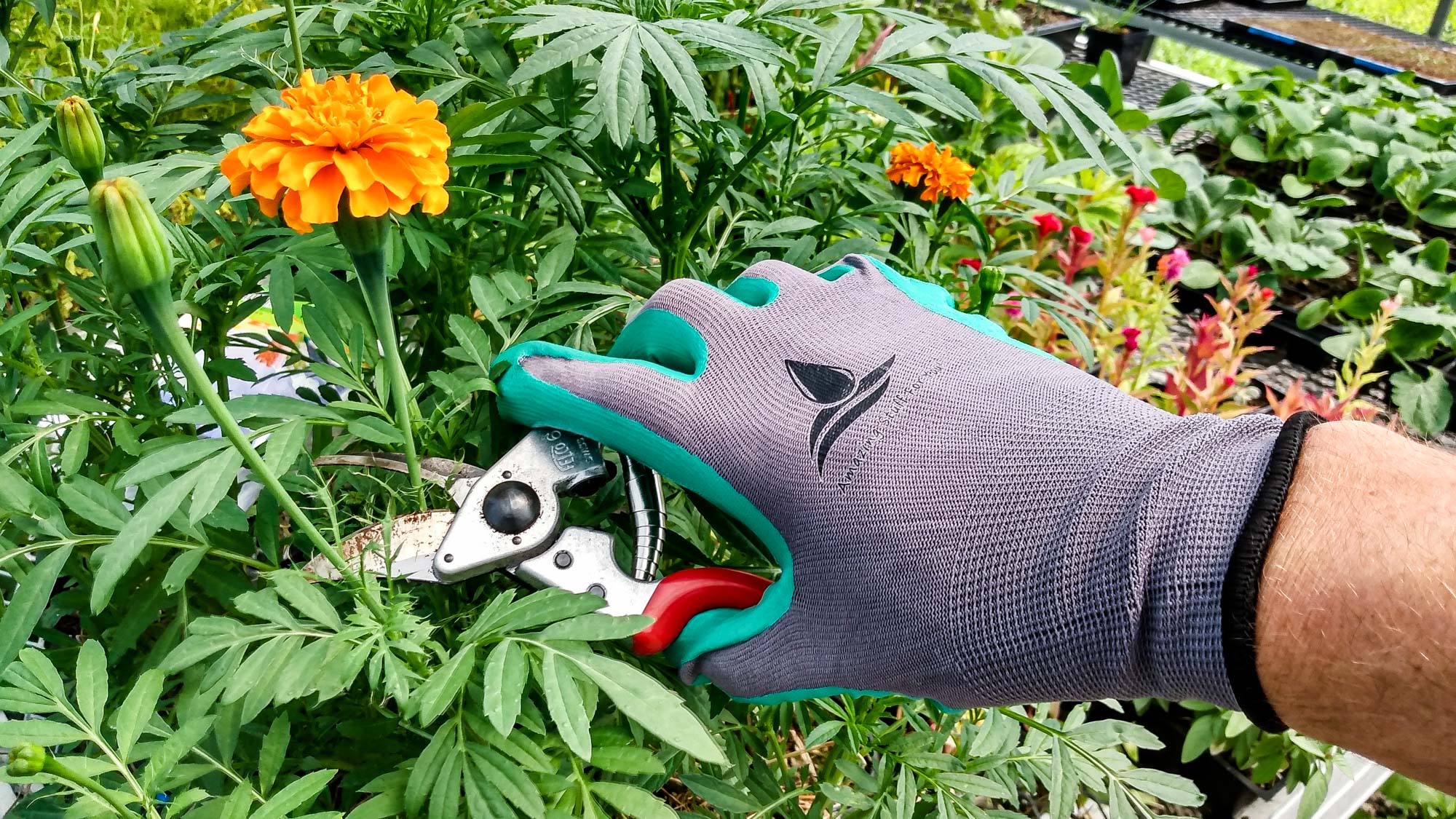
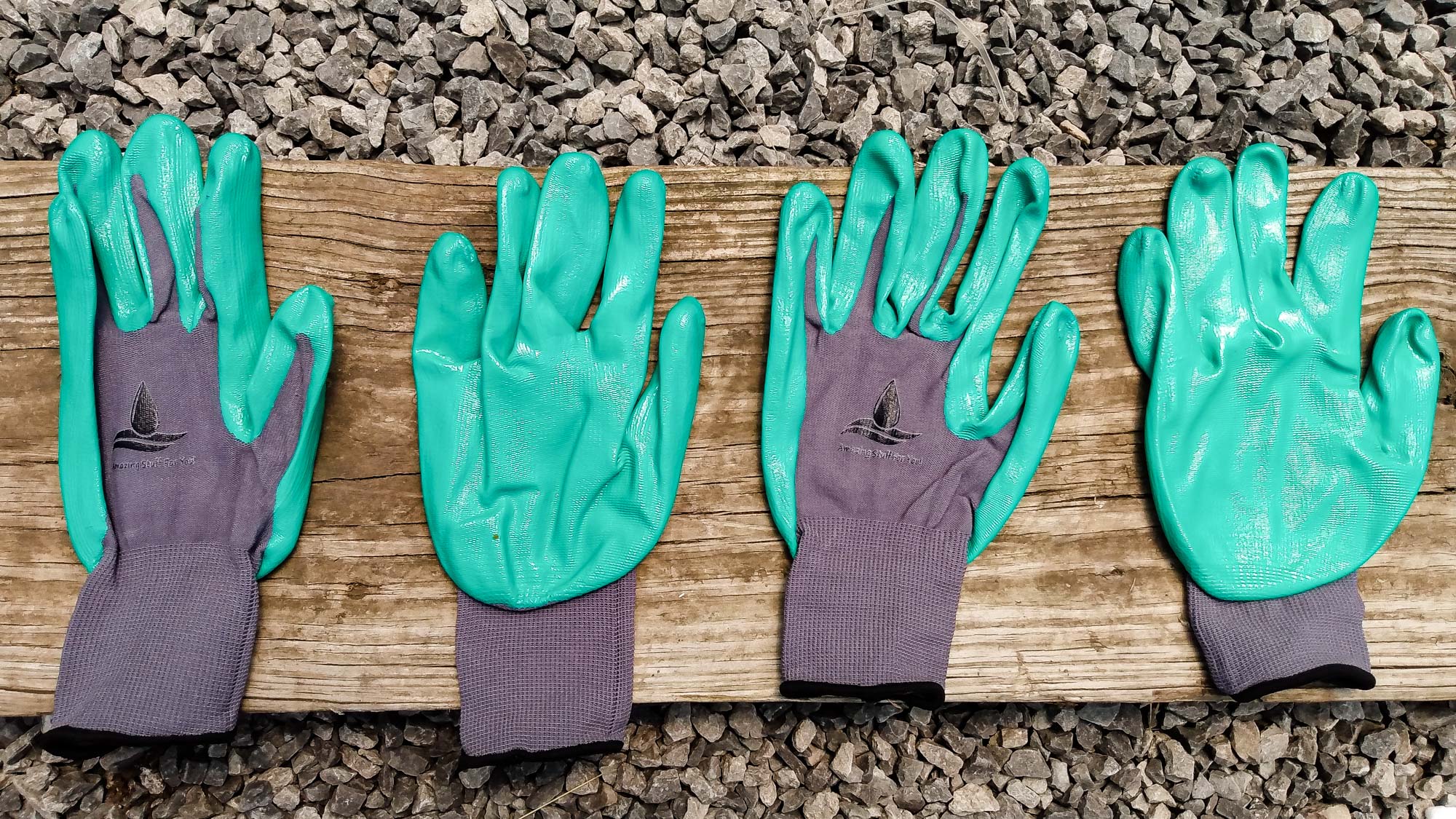
1. Amazing Stuff for You! Garden Gloves (2-pack)
Our expert review:
Specifications
Reasons to buy
Reasons to avoid
The 2-pack Amazing Stuff for You! Garden Gloves are a well-designed nitrile coated glove that are both comfortable to wear and functional in use. The thin nitrile coating offers excellent grip and dexterity in both wet and dry conditions. These gloves are also thin enough that you can feel the delicate stems of vegetable and flower transplants, yet rugged enough to protect your fingers from scrapes, soil and spiky vegetables.
These machine-washable gloves worked very well for harvesting cucumbers and using pruners. Plus, the quality stitching around the wrist kept the gloves in-place. The gloves were able to perform basic smartphone touchscreen functions, although texting was a little cumbersome. Like most nitrile gloves, the mesh backing can let in some loose soil and mud. However, it allows the gloves to breathe so your hands don’t get too hot. Overall, they are a great pair of medium-duty gardening gloves that should last. For a 2-pack, and such a reasonable price point, the performance won’t get much better than this, which is why they’re the best gardening gloves.
Best value
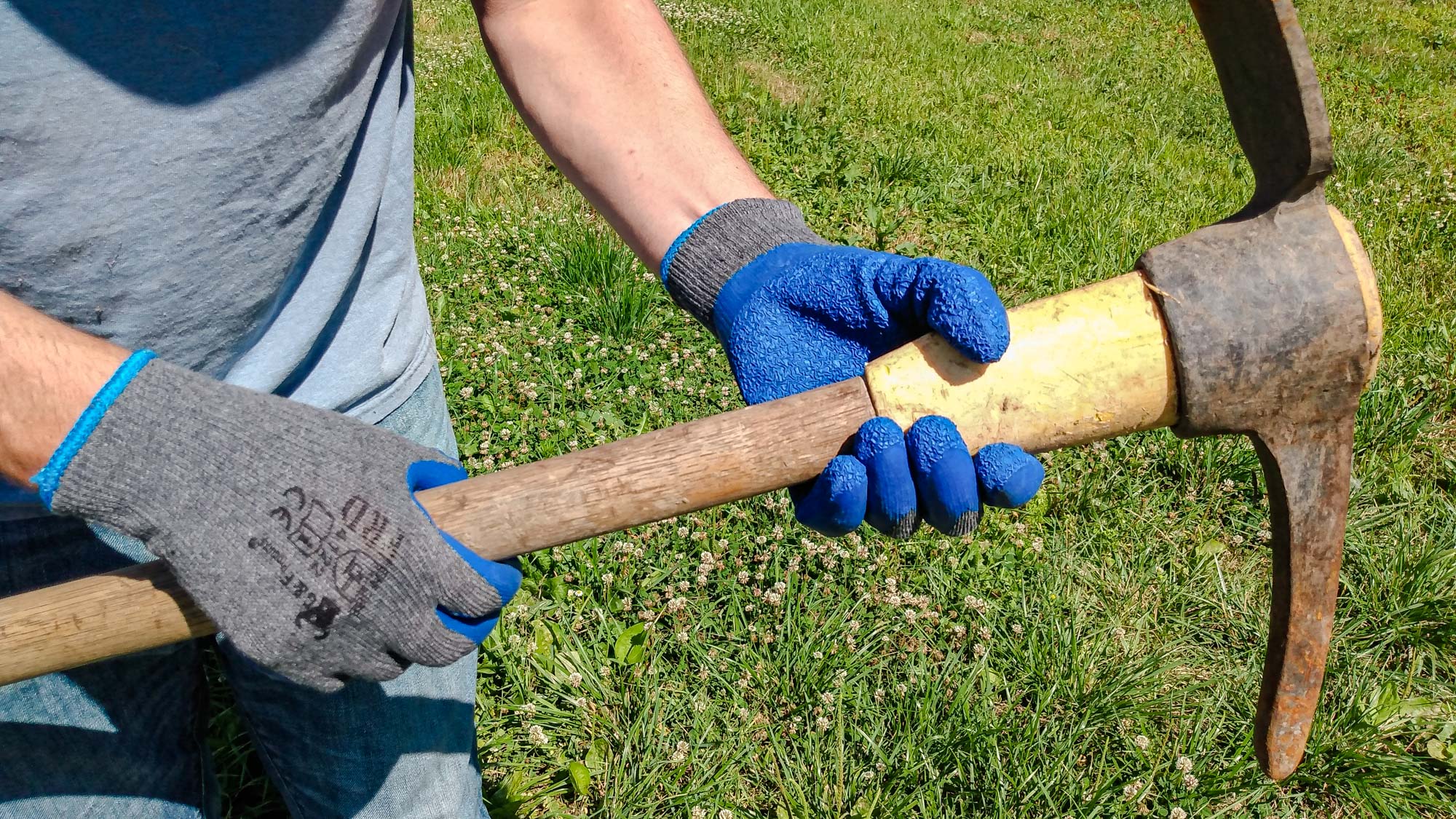
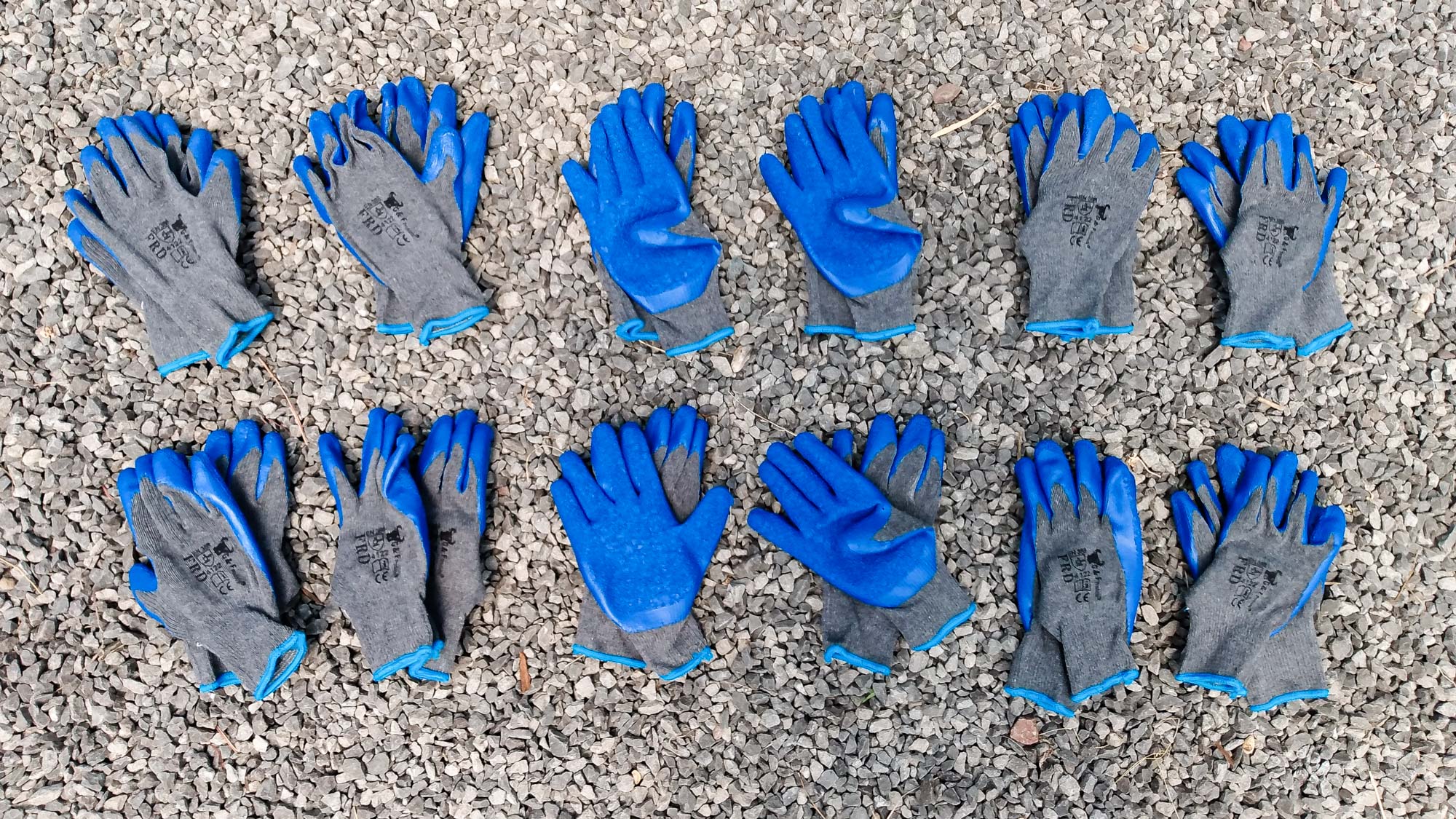
2. G&F Rubber Latex Double Coated Work Gloves (12-pack)
Our expert review:
Specifications
Reasons to buy
Reasons to avoid
The G&F Rubber Latex Double Coated Work Gloves are heavy-duty gloves that come in a 12-pack, making them a great bargain for those who need a large number of gloves. Textured latex coating provides excellent grip on tools, plants and rocks, even when wet. They are thick enough to be warm in cold weather, but breathable enough to be comfortable in the heat.
While inspecting multiple pairs of these gloves, we found that the quality of the stitching was not consistent — some had loose threads that would catch on your fingers as you pulled them on. The color of the blue latex also faded over time working in the sun, but did not impact performance. For the price (less than $1.30 per pair), neither of these imperfections were something to really complain about.
These gloves worked very well with touchscreen phones and were comfortable to use. They performed well in all of the gardening tasks we used them for. Buy these gloves and keep a pair in your car, house, garage and wherever you might need them. These would be a great value for community gardens or beach cleanup projects with multiple workers as they are not expensive and are very durable.
Best for arthritis

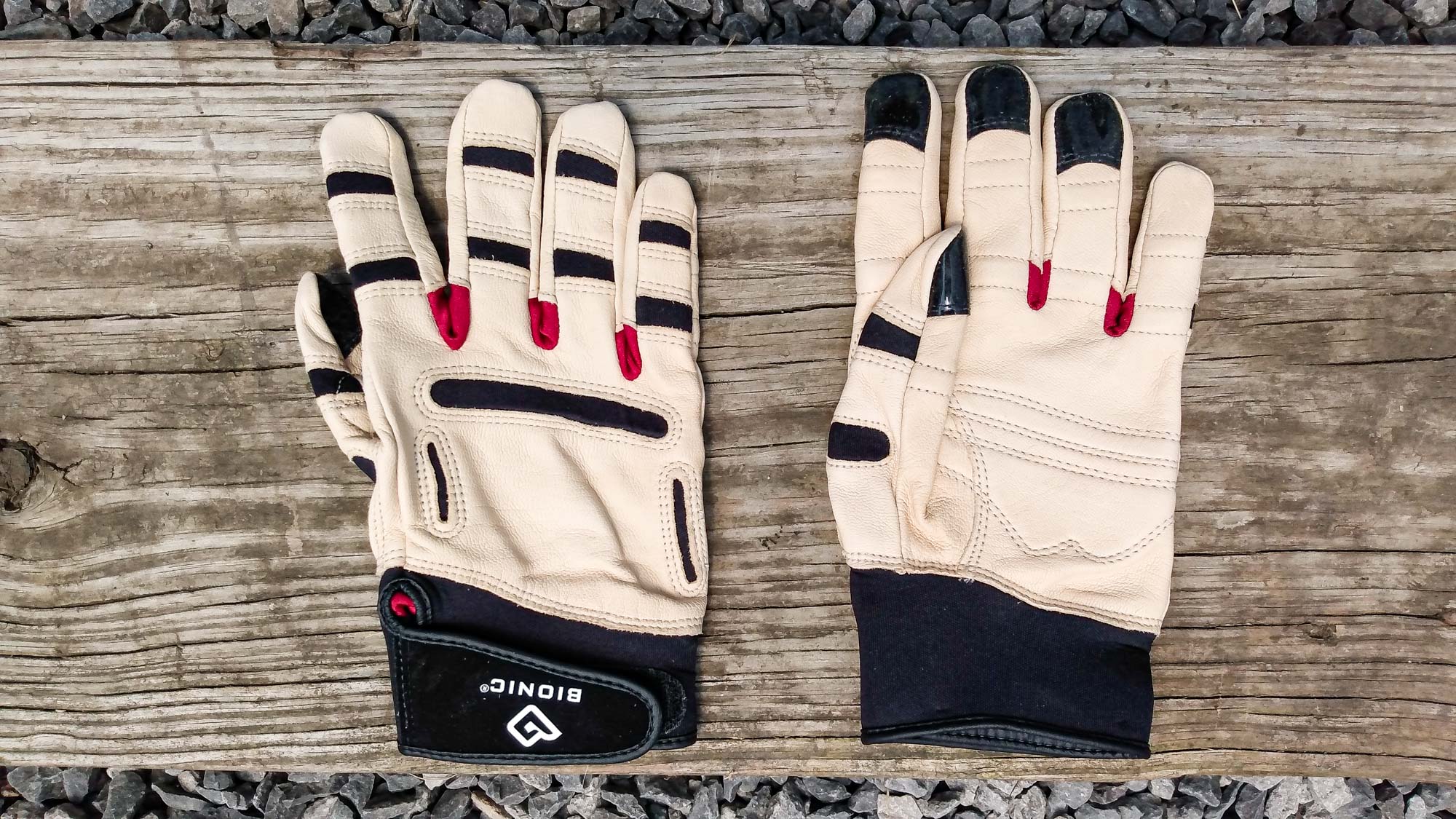
3. Bionic Relief Grip Gardening Gloves
Our expert review:
Specifications
Reasons to buy
Reasons to avoid
What happens when you combine the best parts of a gardening glove, a work glove and an athletic glove all into one? You get the Bionic Relief Grip Gardening Gloves. According to legend (and Amazon), Bionic Relief Grip Gardening Gloves were “designed by an orthopedic hand surgeon with arthritic and sensitive hands in mind.” An outer layer made of double-stitched goatskin leather, neoprene, lycra and silicone offers protection and comfort, while the terrycloth inner liner keeps the hands cool and dry.
Special ‘web zones’ and ‘motion zones’ built into the fingers allow joints to bend with ease. Padding built into the palm and finger creases make most gardening tools comfortable to use and greatly reduces vibration. The silicone fingertips provide superior grip and protection when working with soils and stone. Furthermore, the velcro wrist enclosure allows for a secure fit and dirt protection.
We tested the medium-sized women’s glove, and the fit was just right. While it was true to size, they are designed to be more ‘snug’ than traditional work gloves. The finger padding at the joints did make the gloves a little stiff, but not uncomfortably so. That padding noticeably reduced vibration fatigue when using a gas-powered weed eater. At over $30 a pair, these were the most expensive gloves we tested. And while they might not be as heavy-duty as standard all-leather work gloves, the Bionic Relief Grip Gardening Gloves are extremely well made and are worth the investment. These are definitely some of the best gardening gloves out there.
Best heavy-duty

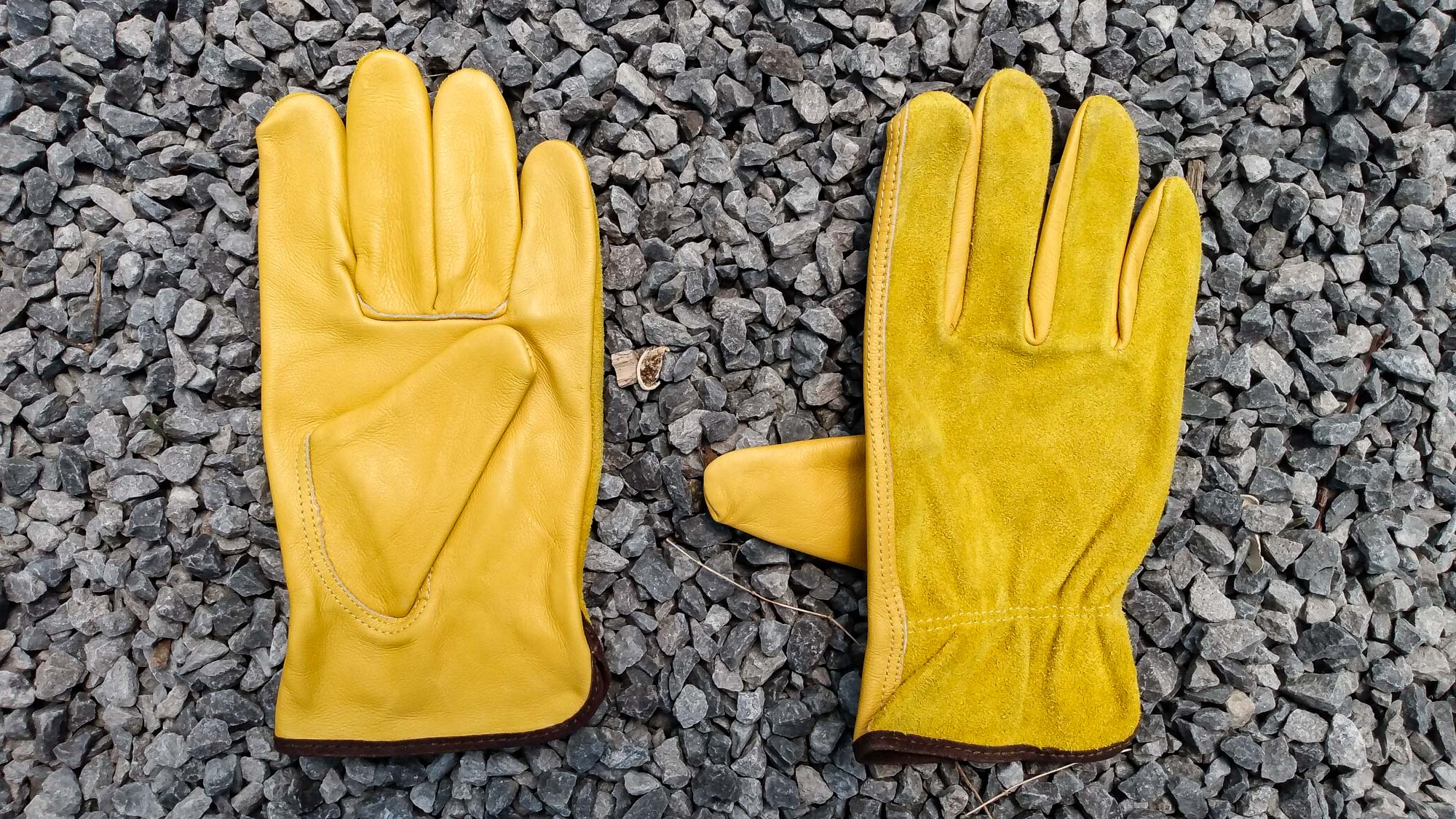
4. OZERO Leather Work Gloves Flex Grip Tough Cowhide Gardening Glove for Men and Women
Our expert review:
Specifications
Reasons to buy
Reasons to avoid
The OZERO Leather Work Gloves offers the protection of puncture-resistant cowhide leather combined with the comfort and dexterity desired in a heavy-duty work glove. This is your traditional-styled work glove with an open cuff and leather backing. There is no extra padding, lining or frills. All seams are double-stitched and held up to the major scrapes and abrasions of moving cinderblocks and pulling vines. It required very little ‘breaking-in’ to feel comfortable. The water-resistant leather stayed soft and flexible even after being soaked and dried in the hot sun.
The size fitted properly with no pinch-points or uncomfortable rubbing. We found that the gold color wore off when scraped, but it didn’t impact its ability to grip tools, even when wet. For some reason, the gloves had a very strong, lingering leather or lanolin smell compared to the other gloves we tested, which might be a deal breaker for sensitive individuals. While these may not be ideal for extended masonry work, the gloves work very well for everything else. Overall, this is a great pair of heavy-duty work gloves.
Best synthetic leather
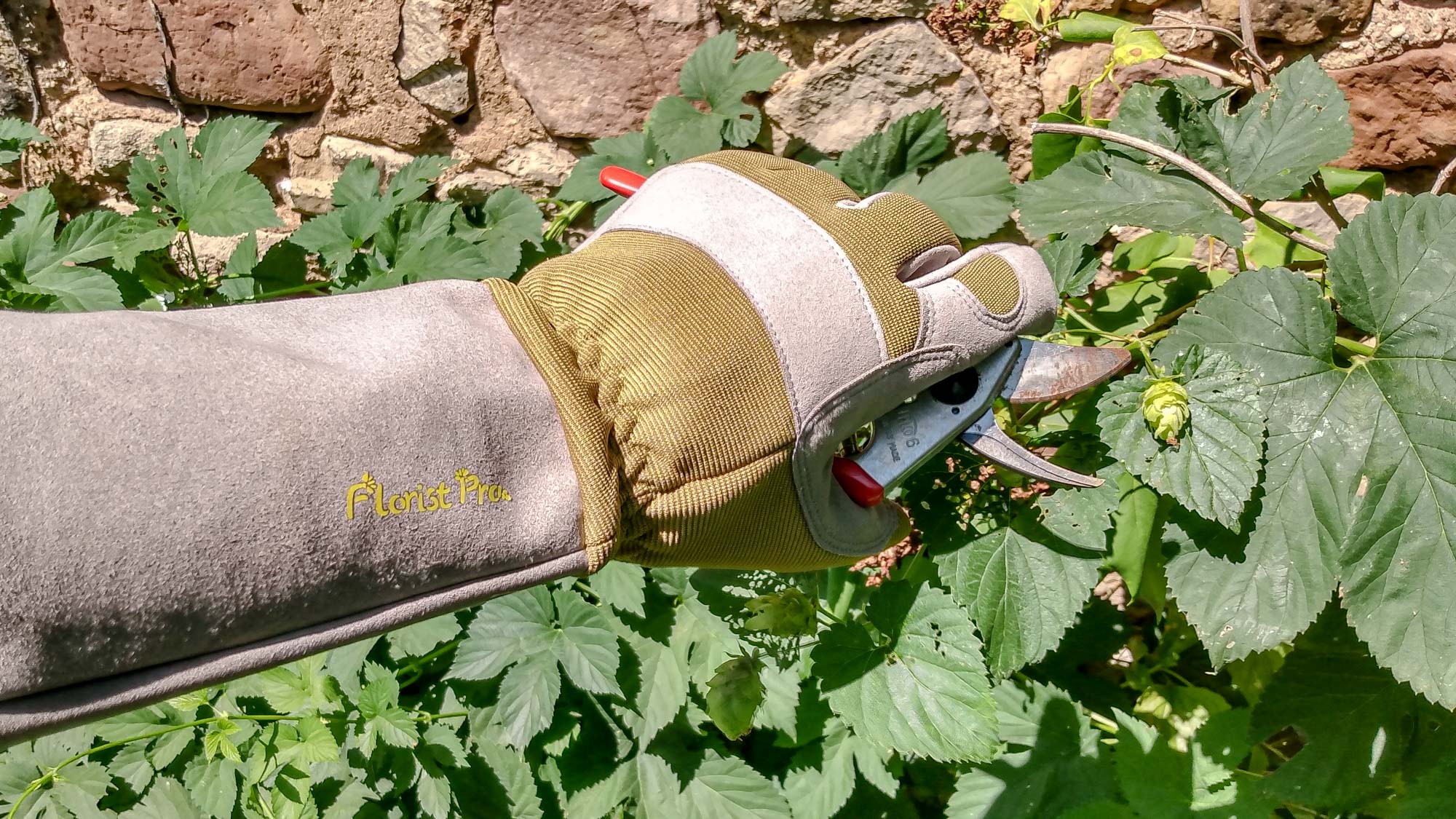
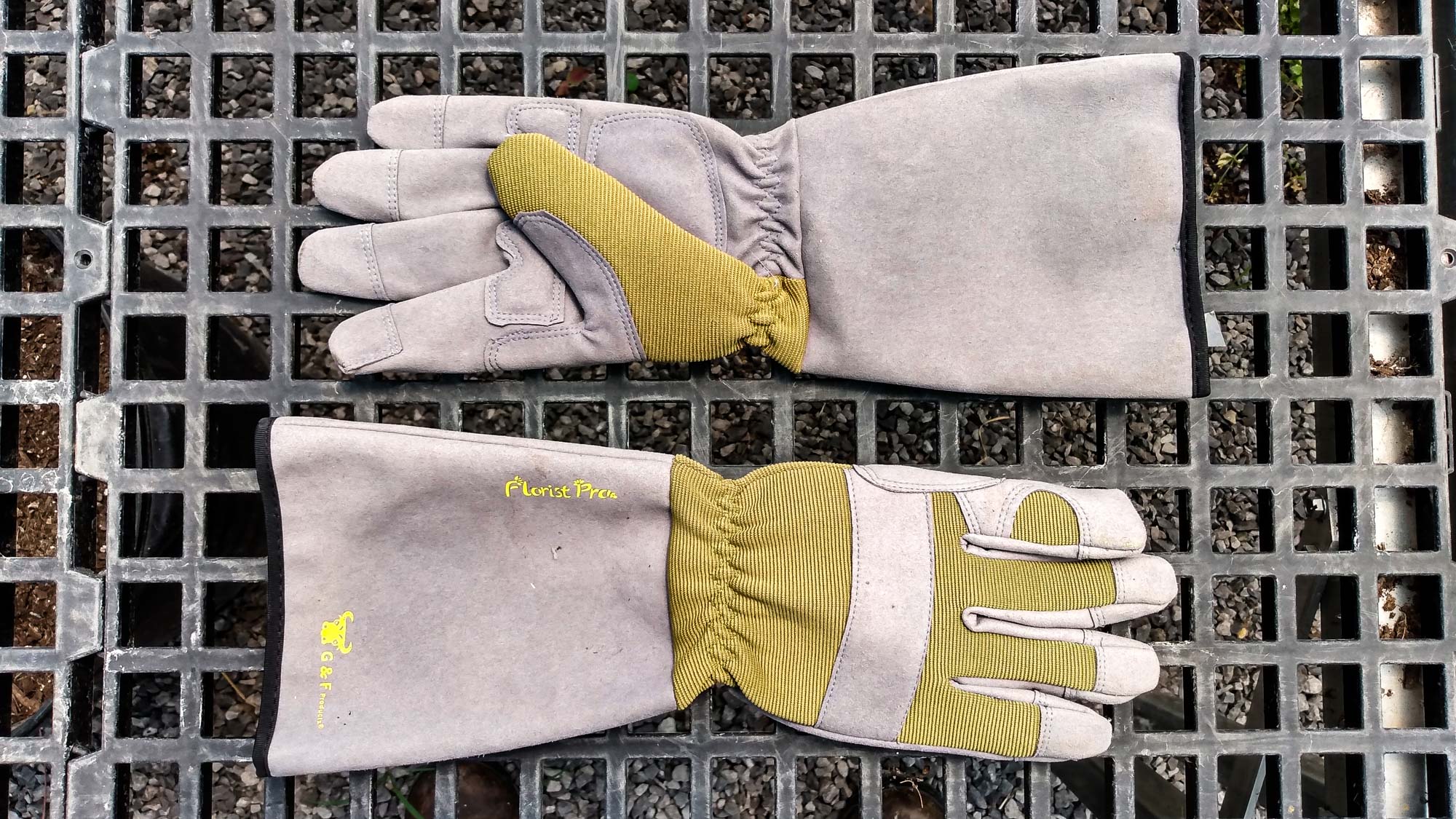
5. G&F Products 2431L Florist Pro Long Sleeve Rose Gardening Gloves
Our expert review:
Specifications
Reasons to buy
Reasons to avoid
The G&F Florist Pro Long Sleeve Rose Gardening Gloves have the features of a heavy-duty work glove, but the protective gauntlet cuff of a rose pruning glove, offering the best of both worlds. All seams on this synthetic leather glove are double-stitched. Reinforced fingertips and padded palm pads allow you to use garden tools just as easily as yanking out stubborn weeds. The breathable mesh back made these gloves good for both warm and colder weather use. However, the backing is not water-resistant.
As with many synthetic leather gloves, there were some blackberry thorns that did manage to poke through, but it was minimal. We did find it to be a great glove for grabbing and removing overgrown zucchini and summer squash plants without getting a single scratch. Although the thumb was a bit large, the overall glove fits well. If you want rose pruning gloves, but don’t want leather, these are the ones to get.
Best for comfort
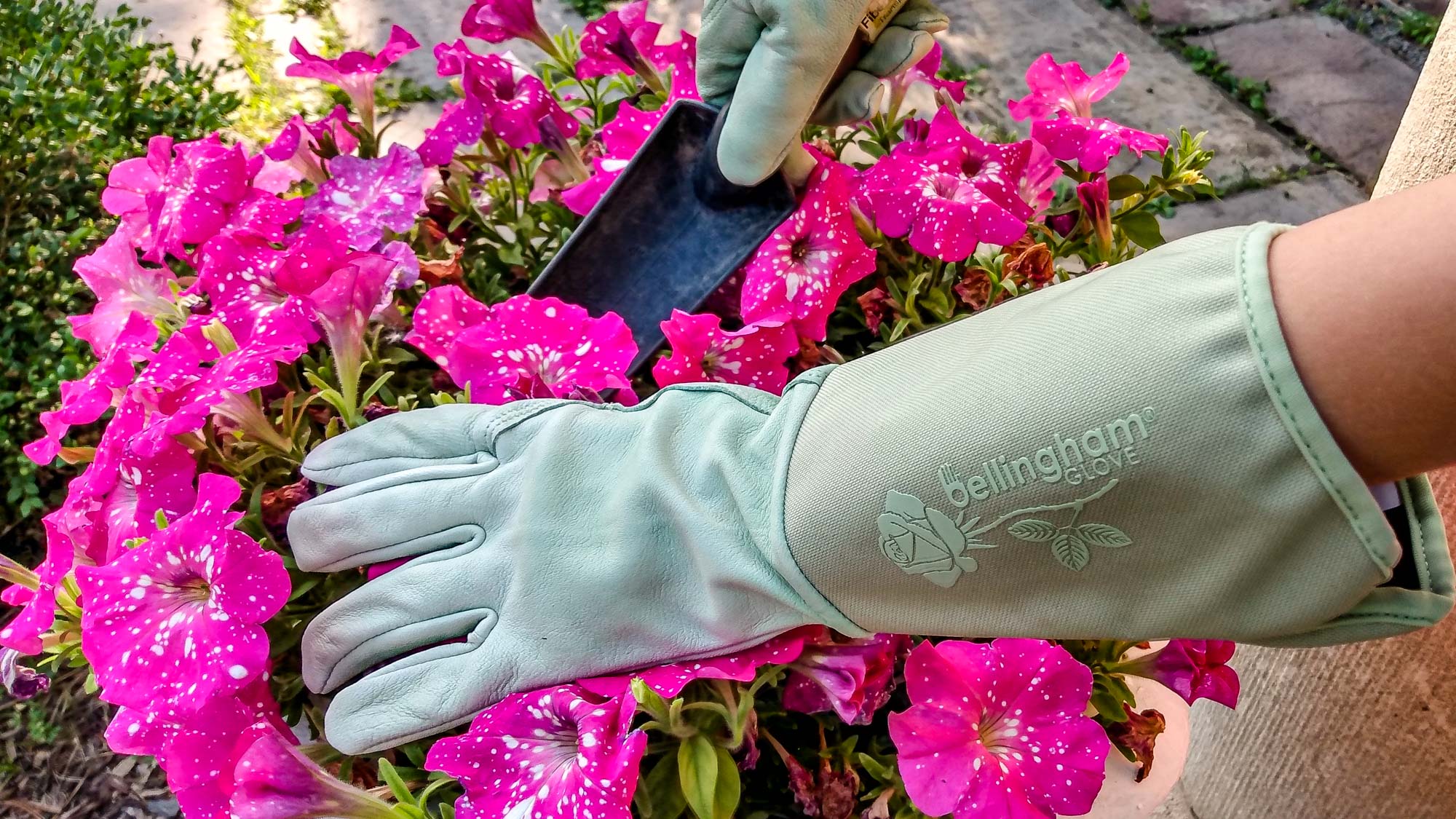
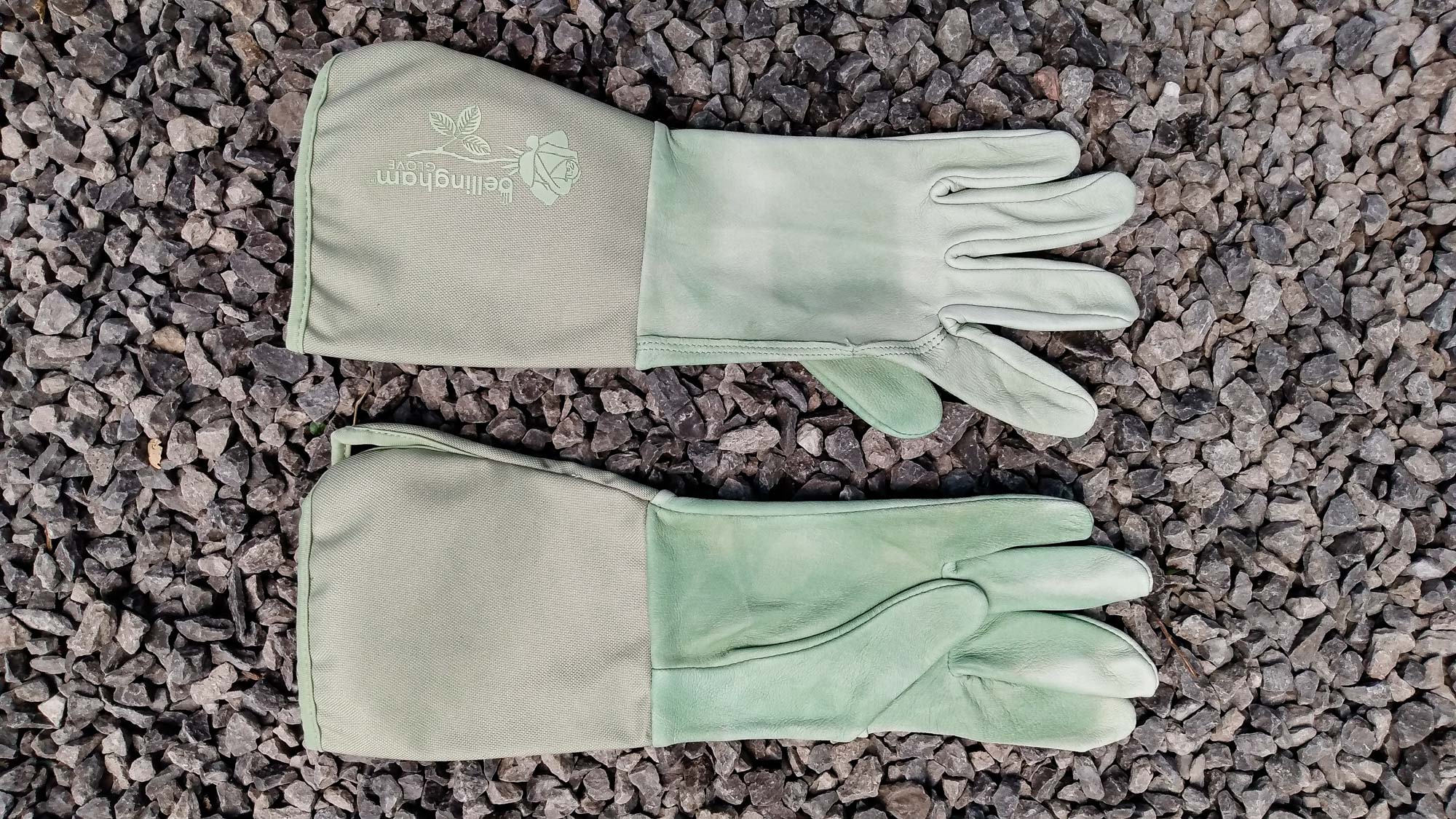
6. Women’s Tuscany Gauntlet Gloves
Our expert review:
Specifications
Reasons to buy
Reasons to avoid
The term ‘Fits like a glove’ comes to mind when using the Women’s Tuscany Gauntlet Gloves. These were the softest gloves out of all the gloves we tested. Made of leather and spandex, these incredibly comfortable gloves provided great dexterity and sensitivity when handling plants. The construction was thick enough to protect against most thistle and bramble thorns, while thin enough to feel delicate flower stems during pruning. These are not heavy-duty gloves. They are made for general gardening and pruning.
It is refreshing to see a gauntlet-style glove designed without any visible stitches in the palm — that means there’s no stitching that can be snagged and pulled by thorns. The wrists do tend to run small on these gloves though, so if you have a large wrist, you’ll want to size-up if possible. Natural lanolin makes these gloves soft, so be sure never to use soap as it will wash away this protective oil. If you’re looking for a second skin while gardening, the Women’s Tuscany Gauntlet Gloves are an excellent choice.
Best gardening glove for small hands
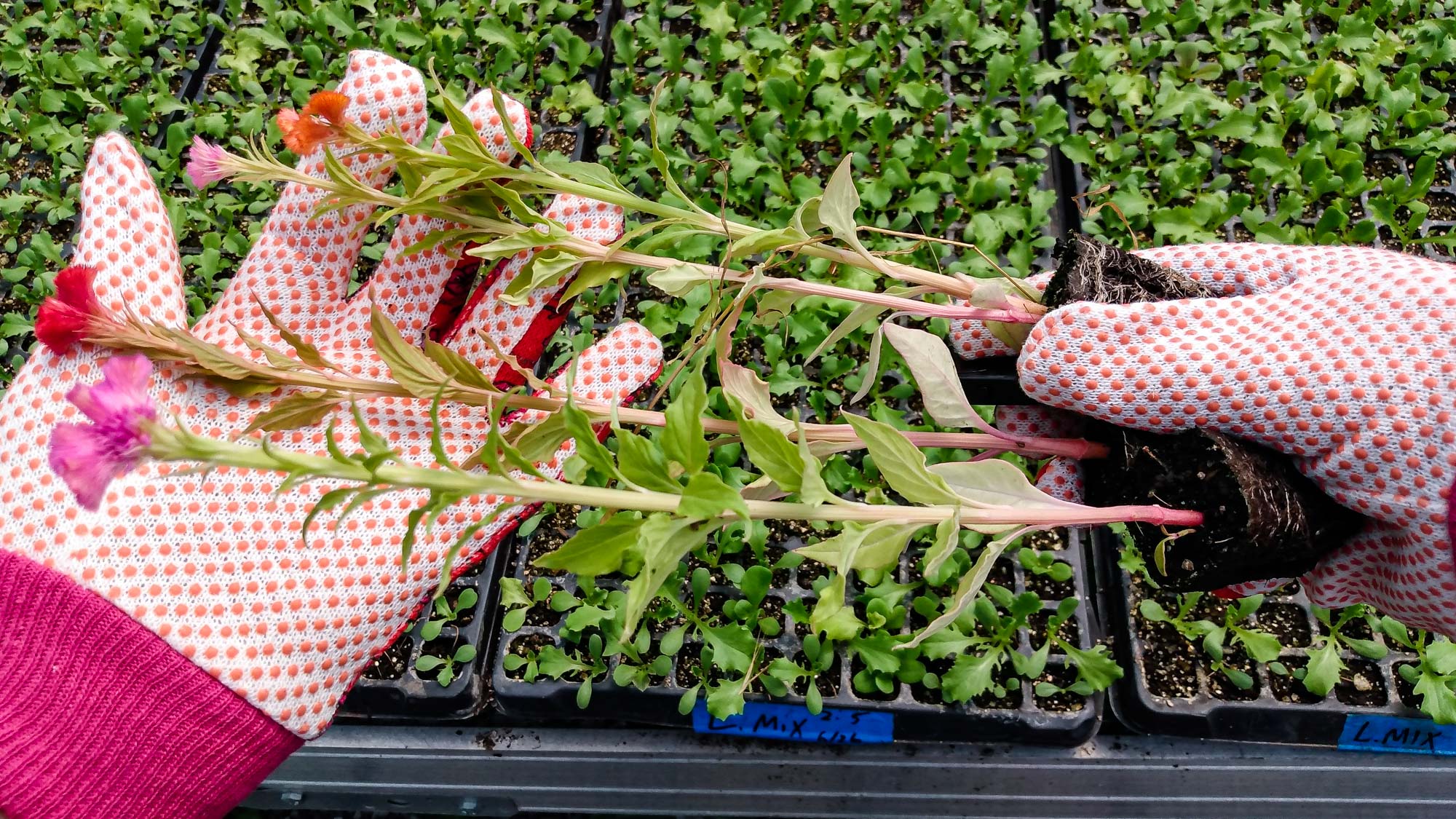
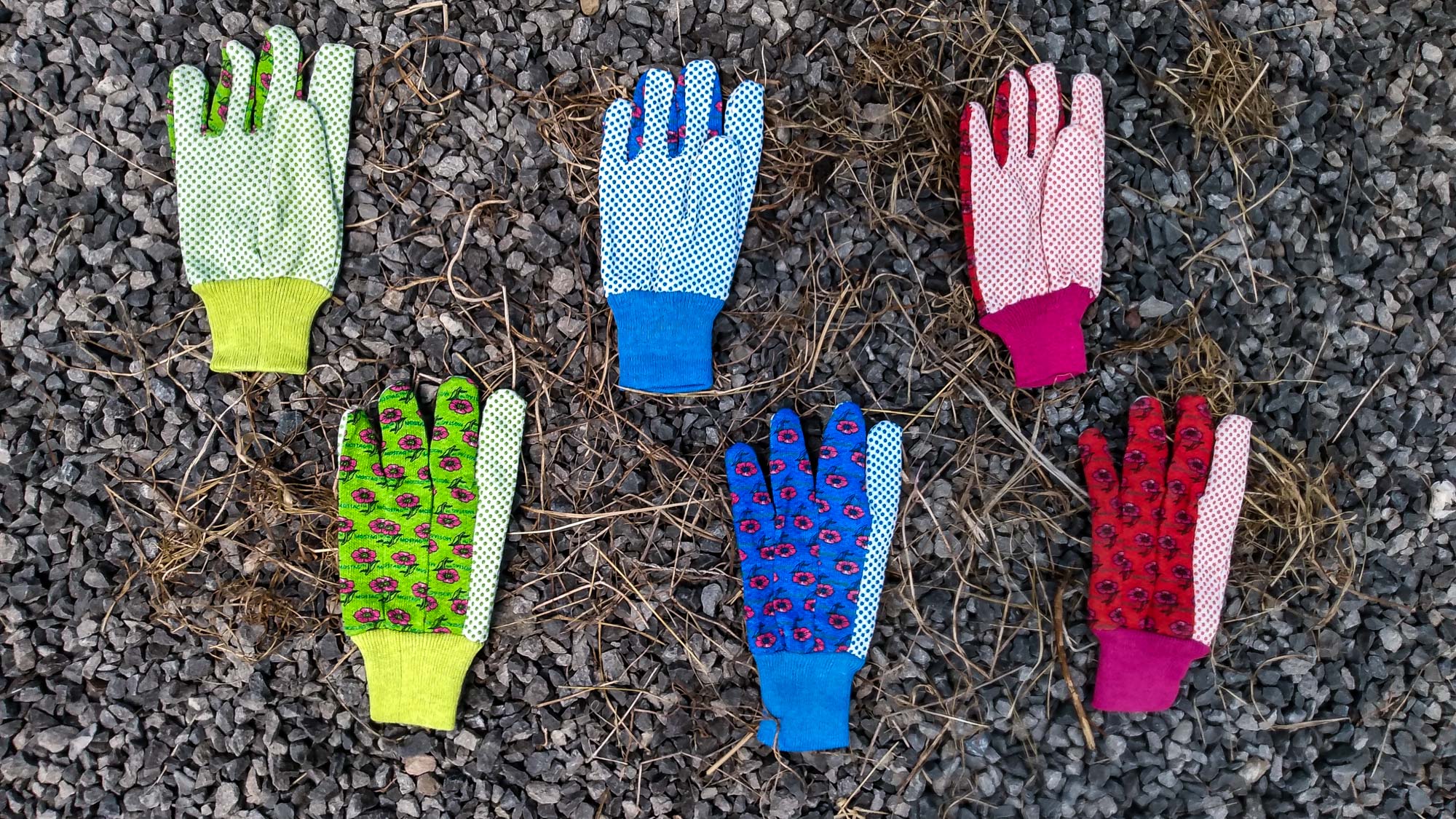
7. G&F 3-pack Women Soft Jersey Garden Gloves
Our expert review:
Specifications
Reasons to buy
Reasons to avoid
The G&F 3-pack Women’s Soft Jersey Garden Gloves provide a colorful twist on the traditional gardening glove. Made of soft cotton and polyester with PVC gripping dots, the gloves provide a balance of comfort, functionality and style. One set includes three bright patterns and colors in red, green and blue. The thickness of the gloves will keep your hands warm in spring or fall, and cool in the summer. The gripping dots also worked well holding a trowel and pruner. They provided nice dexterity for handling fragile transplants.
These gloves do have some limitations. They are not at all water-resistant, and the exposed cloth on the fingers and palm let in fine dirt. In fact, our hands got very dirty while using them to transplant vegetables into the dry field soil, and picked up the smell of the fertilizer water that was in the roots. The soft jersey also tends to snag on sharp thorns and branches. That being said, they do work very well for pruning and moving plants. Their sizing helped earn these gloves the title of ‘best gardening gloves for small hands.’
Best forearm protection
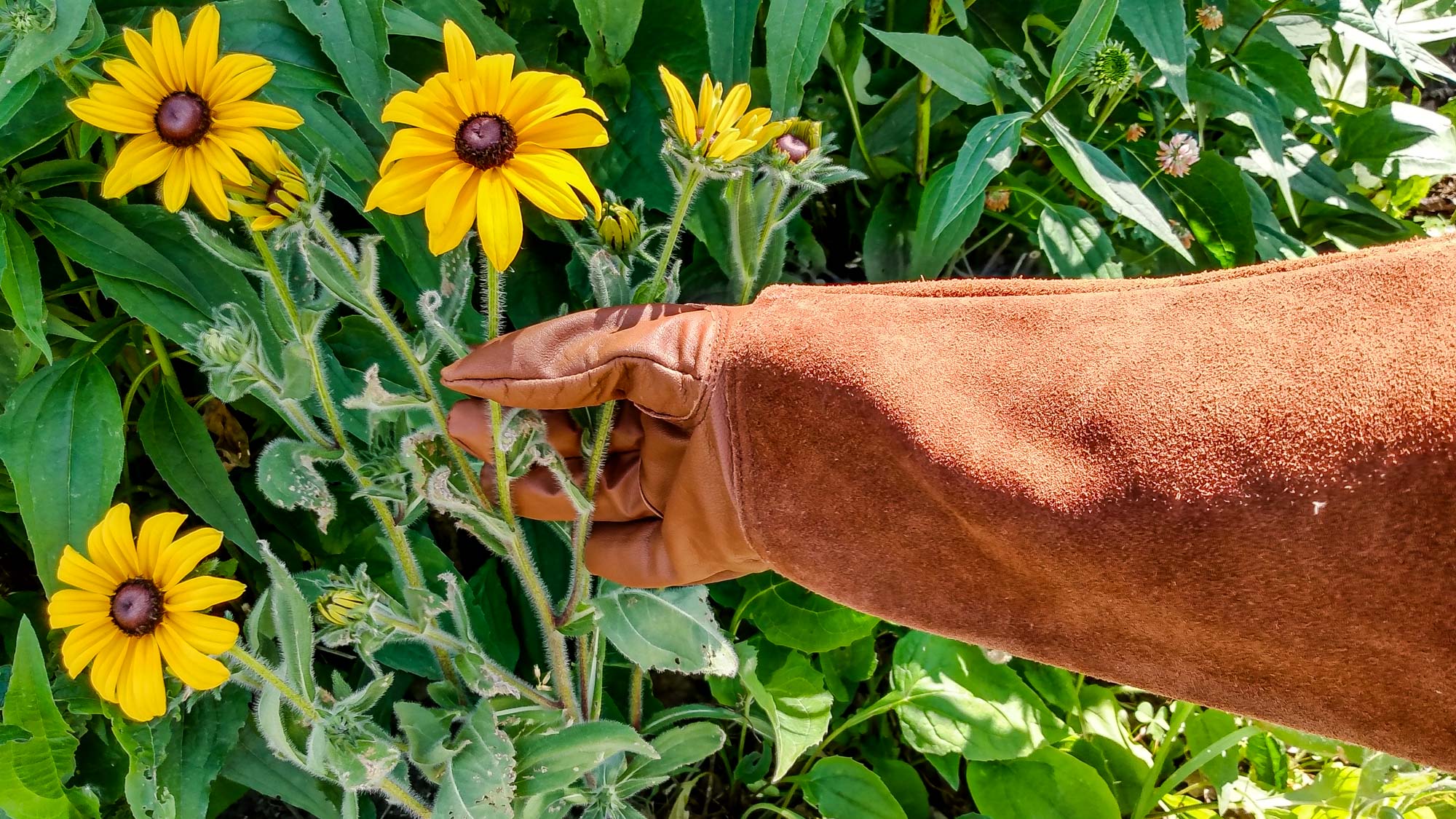
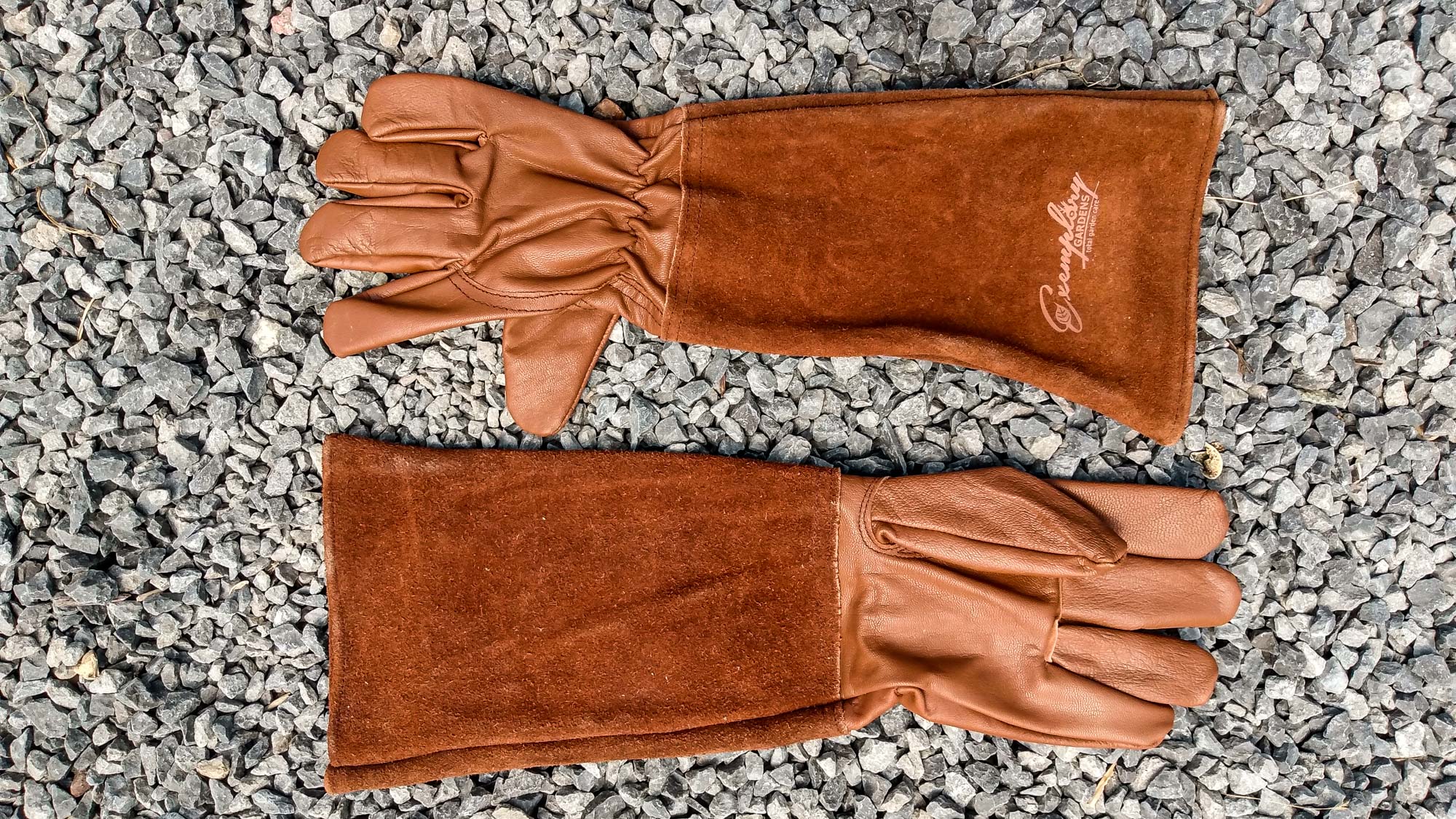
8. Rose Pruning Gloves
Our expert review:
Specifications
Reasons to buy
Reasons to avoid
These Rose Pruning Gloves are made of soft goatskin leather. They provide excellent grip and dexterity while handling pruners and pulling vines. Plus, they are water-resistant and have a thick, heavy leather gauntlet for superior forearm protection. Some seams do poke through on the fingertips and on the wrists, but it is not uncomfortable for extended periods of work.
No blackberry thorns came through while pruning back a bush. We found these offered excellent hand and forearm protection while pulling thistle and overgrown zucchini plants as well. There was, however, a fraying seeam on the right palm and a missed stitch created a small hole between the ring and middle fingers. Besides those imperfections, the gloves seem very durable.
The gloves run a little large — they were a good fit for a large hand even though it was sized for medium. If you are undergoing a project where you need to protect your forearms, these would be the best gardening gloves for you.
Best for knuckle protection
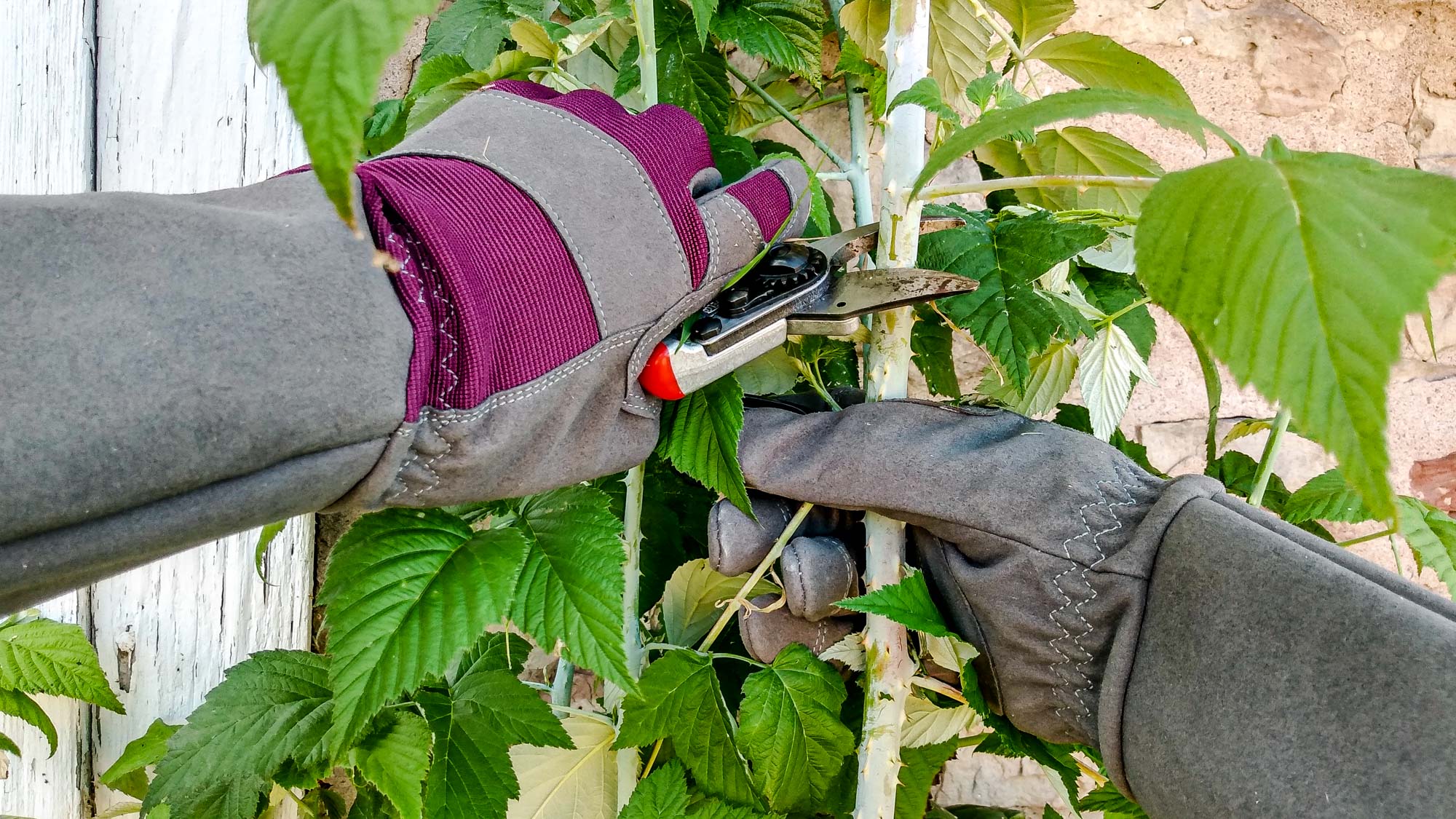
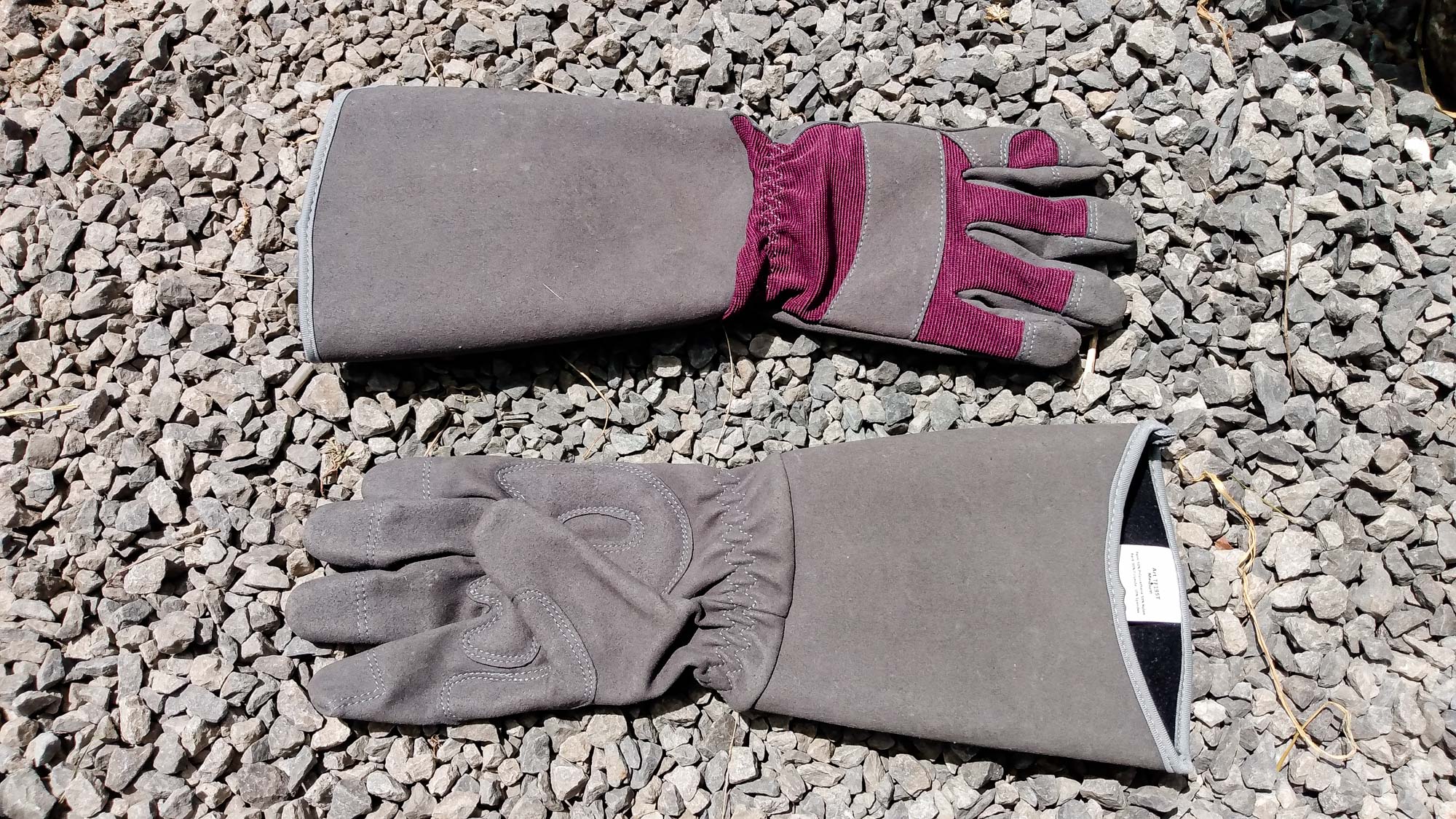
9. Magid Professional Rose Pruning Thorn Proof Gardening Gloves
Our expert review:
Specifications
Reasons to buy
Reasons to avoid
The Magid Professional Rose Pruning Thorn Proof Gardening Gloves are made of soft, synthetic leather (nylon, polyurethane, polyester and spandex) with a thick, protective cuff. These machine washable gloves are comfortable and well-designed. In terms of functionality, they are designed similarly to work gloves, but have the added protection of a long gauntlet.
Padding stitches across the palms reduces friction and vibration, making them great for handling string trimmers and hand tools. All seams are double-stitched and the fingertips are reinforced. It is worth noting though that while the mesh back of the glove is breathable, the thick foam cuff became uncomfortably hot while working in the sun. The rubbing of the thick gauntlet cuff on the forearm, especially around the seams, caused some discomfort over time when worn without sleeves as well.
Like most synthetic leather gloves, there was some poke-through of thorns, but it was minimal. They offered great protection while pulling thistle as well. However, the gloves have a thin mesh on the back of the hands which makes them poor candidates for reaching into thorn bushes or using in wet conditions. The Magid Professional Rose Pruning Thorn Proof Gardening Gloves have excellent knuckle and finger protection though, which is why they make the list of the best gardening gloves.
Best grip leather glove
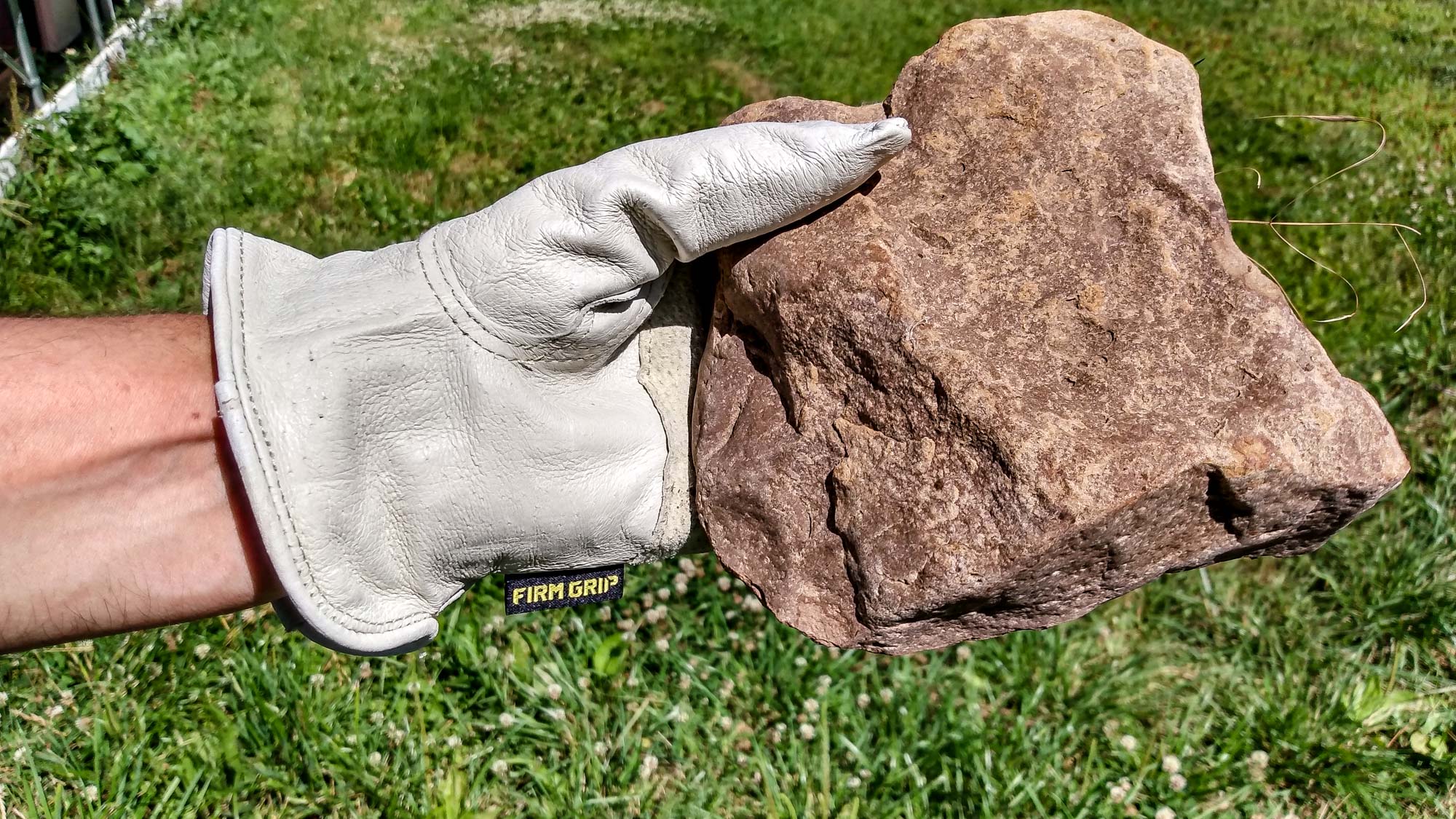
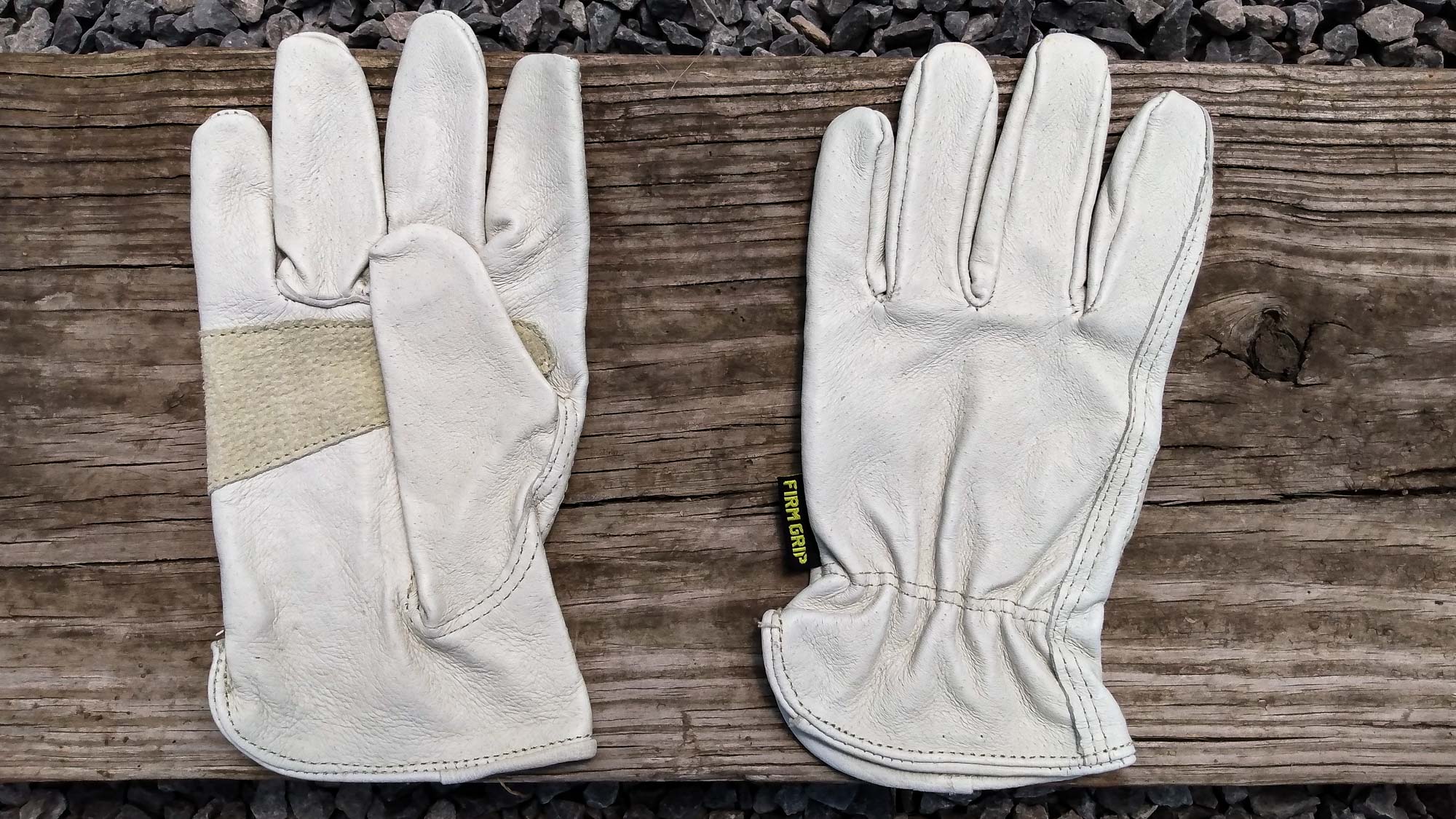
10. Firm Grip Pigskin Leather Work Gloves
Our expert review:
Specifications
Reasons to buy
Reasons to avoid
The feature that makes the Firm Grip Pigskin Leather Work Gloves stand apart from other heavy-duty leather gloves is that they are breathable. Micro holes in the leather help prevent your hands from sweating and overheating while working in the sun. This double-stitched work glove has a reinforced palm to help prevent calluses while using hand tools. However, we found the gloves to be very stiff, especially after getting wet and drying in the sun, but they do break in over time.
The Firm Grip Pigskin Leather Work Gloves are very strong, well-made and offer great protection from rocks and scraping. These had excellent grip on rocks and tools, even after being soaked. In fact, we used them explicitly for rock picking one damp morning, and they held up very well and maintained an excellent grip. However, the thumb seemed a little long, slightly reducing dexterity. Also, the cuff is very wide, allowing dirt and weeds to enter through the top. That being said, this is overall a great pair of work gloves which will take a beating so your hands don’t have to.
Also tested
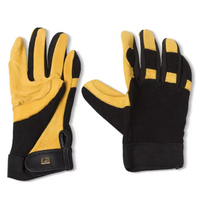
Despite having positive reviews, I was disappointed with how these gloves performed. There's no doubting that they are amazingly soft and comfortable, and they have a handy strap to tighten the cuff, however, when I started to work with rough material, the yellow coating on the gloves came away, even after short-term use. For this reason, they didn't make the cut into our guide.
Who this is for
Even the hardiest of gardeners will use gardening gloves at some point, while others will use them for every gardening task, including taking care of houseplants. Although they are not always needed for every task, such as pinching out plant stems, when you require dexterity, they will protect your hands and arms from sharp thorns and wood splinters when performing robust jobs.
I have multiple pairs for different tasks, and prefer a lighter, more nimble pair for general use, while I’ll wear a thicker pair with arm protection for tougher tasks.
How we selected and tested the best gardening gloves
There are hundreds of lawn and garden gloves available on the market. The gloves chosen for this test were selected because they ranked among the highest in terms of product reviews from reputable brands and vendors. We were looking for gloves that were comfortable, durable and provided a proper balance of dexterity and functionality.
Each of the gloves featured in our best gardening gloves list have been hand tested by, Rich and Bree Woodward, an experienced farming couple while planting, harvesting and maintaining the property on their historic farm. I've also started to test other gardening gloves, and will continue to update the best that are available.
Glove categories
During Rich and Bree's testing, the gloves were separated into gardening, pruning and work categories. And each pair of gardening gloves were used to transplant, prune and harvest vegetables.
Dexterity
Testing focused on dexterity — removing fragile transplants from seeding trays while also assessing the hand protection and dirt exclusion. The pruning gloves were used to prune thorn bushes with the best pruning shears. While the couple pulled out tangles of wild grape vines and overgrown zucchini plants. The work gloves were used to shovel compost, pick up field rocks and drive fence posts. They were also used to hold and control a gas-powered weed trimmer to test for vibration protection and grip.
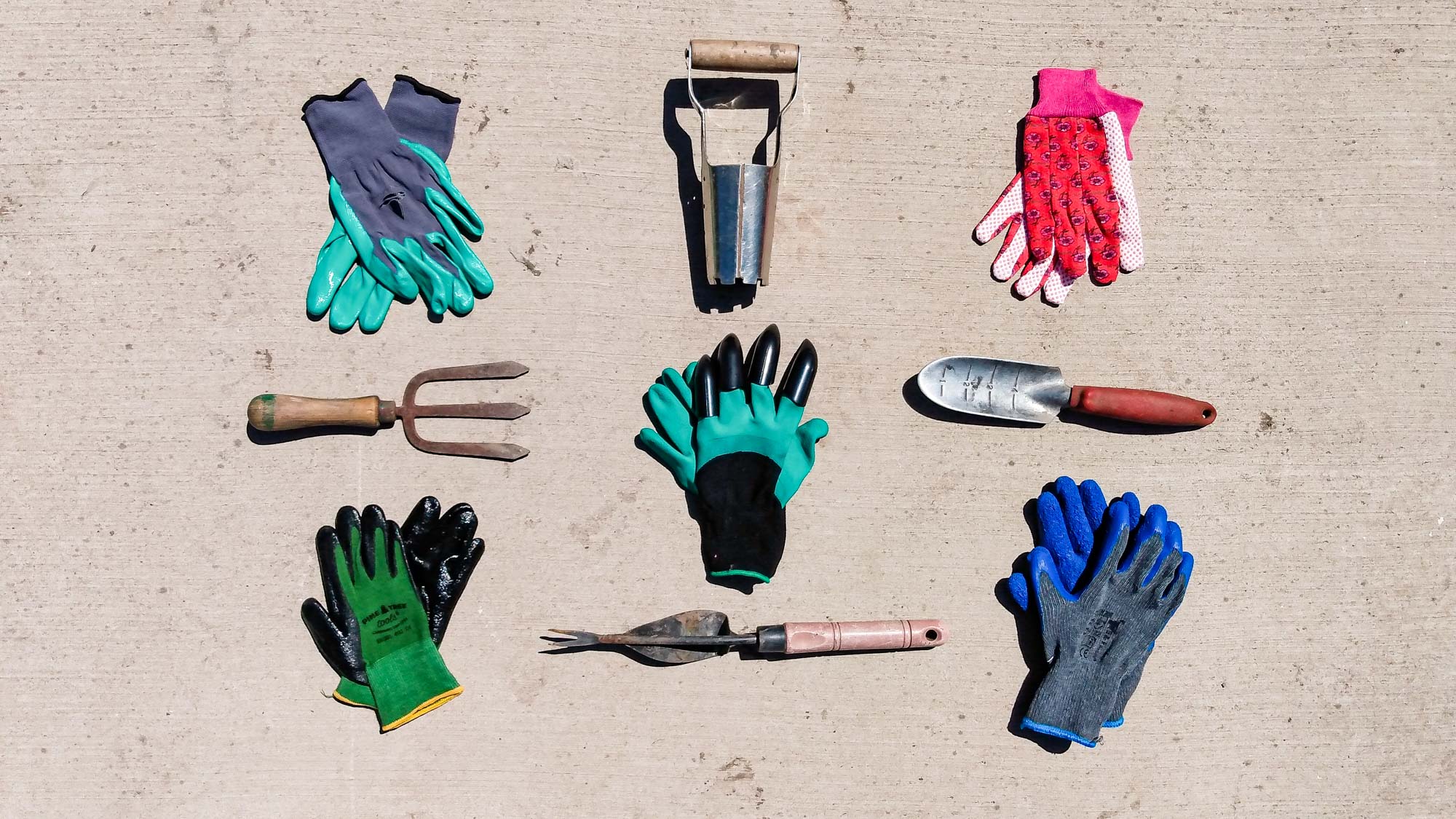
The water test
At the end of testing, all gloves were soaked with water to test the wet-grip while holding a rake, and then each pair was set out in the sun to dry and then worn again to test for shrinking or loss of flexibility.
Durability
The fronts and backs were also rubbed on concrete to assess the long-term durability of the material and stitching.
Gardening gloves FAQs
How to choose the best gardening gloves for you
While having a little dirt under your fingernails is a badge of honor for many gardening enthusiasts, a brush with poison ivy or repeated scratches from a zucchini plant can have you singing a different tune.
There are three primary styles of gloves used in lawn and garden work; work gloves, rose pruning gloves and gardening gloves. Some companies specifically design ‘Women’s’ or ‘Men’s’ gloves, while others are gender-neutral (unisex) and offer a range of sizes.
Work gloves are designed to protect both the front and the back of your hands from abrasion while doing landscaping work, such as moving rocks, raking or using heavy tools.
Rose pruning gloves are typically looser fitting leather gloves with a long cuff or gauntlet that protects your hands and forearms from thorn punctures and noxious weeds. Secretly, they also come in handy when grooming cats that don’t like to be groomed.
Gardening gloves are typically light-weight and tight-fitting to allow for good dexterity when handling small plants and hand tools. Many can also double as work gloves.
What material should you get?
Real leather (pigskin, goatskin or cowhide) will typically be the most puncture resistant of any glove material. These are used in a wide variety of industries because they offer such a high degree of protection. Natural lanolin is often applied to keep the gloves soft, so you should avoid using any kind of soap to clean real leather gloves — it can dissolve the oils and dry out the material. Brand new brightly colored leather gloves have a tendency to stain your skin if they get wet or sweaty, so read the reviews to check if that’s an issue before purchasing.
Synthetic leather is often more ‘breathable’ and comfortable than genuine leather, but can wear out quickly due to repeated abrasion (especially in the fingertips). These are also not as good as leather for handling thorns, although they still offer great protection from blisters and abrasions. Many work gloves feature a synthetic palm and fingers while sporting a flexible fabric around the back of the hand for increased dexterity. Synthetic leather gloves are a nice alternative option for vegan gardeners and are often machine washable.
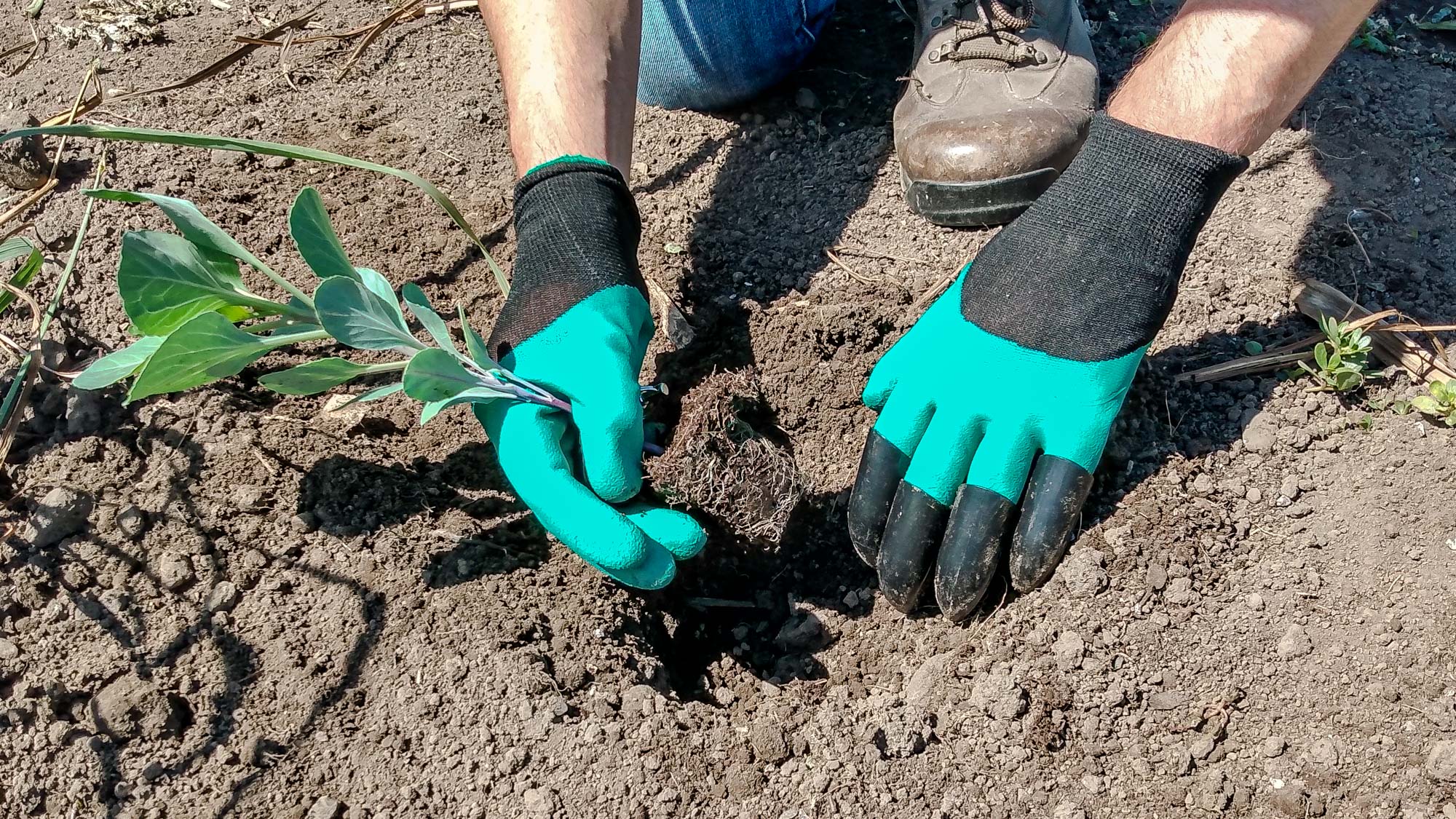
Nitrile and latex are thin, rubbery coatings which are often found on a woven mesh glove — each with water and chemical-resistant properties. Nitrile is a safe alternative for those with latex allergies. They both offer superb grip and dexterity, even in wet conditions. Plus, they are very light weight, tight fitting and offer a great range of motion. However, neither material is puncture resistant, so avoid using them when handling thorns. Nitrile and latex gloves are both touch-screen compatible as well, so these are a good option if you need to use your phone while working.
Knit work gloves are typically made of cotton or cotton/poly blends and are machine washable. They are lightweight and very comfortable when compared to the heavier and stiffer leather and synthetic options. Some styles of knit work gloves have non-slip nitrile or latex incorporated into the palm and fingertips for added grip. Knit gloves are breathable in the warm summer and offer a degree of warmth in the cold. They are not designed for heavy-duty or wet work and will tend to snag on thorns. However, they are a comfortable option for light yard work and gardening.
Quality of construction
If a glove isn’t made well, it’s not going to last. If you are in the market for leather or synthetic leather gloves, make sure the seams are double-stitched, especially on the palms. If you’re moving rocks or branches, a single stitch will eventually fray, fail and start pulling apart. Some gloves may also look good on the outside, but they can have loose stitching or rough seams on the inside that snag and rub against your skin, so be sure to check this. Nitrile, latex and knit gloves can sometimes have loose strings around the cuffs and fingertips that feel uncomfortable in use. The quality control standards were all high for the best gardening gloves featured in this list.
Choosing the right glove for the right job
You should always use the right tool for the right job, and gardening gloves are no exception. While no one will stop you from using pruning gloves for planting vegetables, that is not what it is designed for, which means its use can result in discomfort and frustration.
Tough leather work gloves might last you years when utilized for basic lawn and garden work, but these can wear out in a day of working with wet concrete blocks. And while nitrile gloves provide superior gripping strength, their tightness can create ‘hot spots’ that lead to blisters when using hand tools like post pounders or a pickaxe. A good work glove reduces the chances of developing blisters in these instances.
Even the best gardening gloves can fail when used improperly. That’s why it is a good idea to have multiple glove types available for all work occasions.
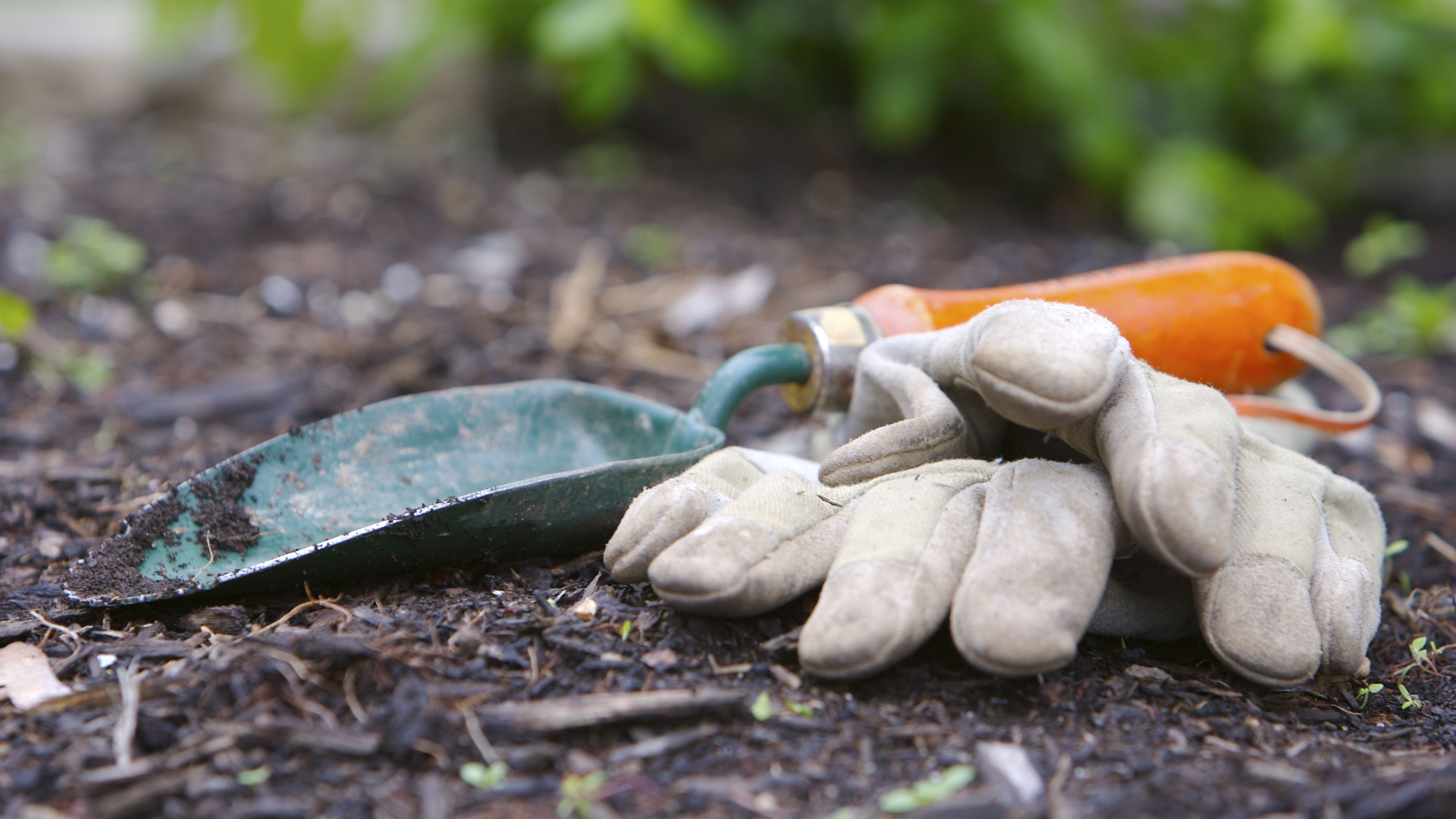
How to find a glove that fits your hand
You may have heard the saying, ‘fits like a glove,’ but what does that actually mean? How is a glove supposed to fit? It turns out that not all gloves are supposed to fit the same. Most heavy-duty leather work gloves and pruning gloves should be loose fitting. It reduces rubbing and the formation of ‘hot spots,’ which, in turn, prevents blisters. Garden gloves (including nitrile and latex gloves) are designed to be close fitting, allowing for an improved sense of touch and dexterity, while still providing excellent grip and protection.
Some companies specifically design ‘Women’s’ or ‘Men’s’ gloves, while others are gender-neutral (unisex) and offer a range of sizes. Like most clothing options, the sizing is often at the whim of the producer. Women’s gloves are typically smaller than men’s gloves, however, the craftmanship is the same. Gender-neutral gloves often run slightly larger to fit men’s hands, so women may need a size smaller if they’re considering these. Glove sizes are typically determined by measuring the circumference of the palm just under the fingers and the length from the base of your palm to the tip of your middle finger.
The Bionic Relief Grip Gardening Gloves description on Amazon offers a sizing chart along with a diagram to show how to make the measurements. Always read the Q&A section and reviews to see if the gloves run larger or smaller than normal.
How to properly maintain your garden gloves
Gardening gloves get dirty. There’s no way around it. You might be tempted to throw your gloves in the washing machine or use a bar of soap to give them a good cleaning, but read the label before you do. Many nitrile and synthetic leather gloves are machine washable (cold water, air dry). However, most genuine leather gloves are ruined if washed with any type of soap. Lanolin is a natural oil used to soften the majority of leather gloves. Washing with soap removes the lanolin, leaving the leather very stiff and uncomfortable to wear. For genuine leather, simple tap water and a gentle fingernail brush will remove much of the dirt without damaging the lanolin. When in doubt, check the label or product website.
Like any tool, never put gloves away wet. There’s nothing quite like pulling a moldy, rotting glove out of the trunk of your car. Wash your gloves when they need it and make sure they are thoroughly air dried before putting them away. The UV light from the sun can break down the polymers in synthetic leather, and weaken latex and nitrile. Ideally store your gloves in a dark, dry location like a glove box or a drawer.
Our work continues
Our work to improve this guide continues, as we review further gardening gloves, which will be included in the guide if they meet the grade. One aspect we're eager to share is washable gardening gloves, as we know that gloves can become worn and shabby with dried-in dirt. We also want to hear if you've used an exceptional pair of gardening gloves and why you rate them so highly.
Sign up to get the BEST of Tom's Guide direct to your inbox.
Get instant access to breaking news, the hottest reviews, great deals and helpful tips.

Camilla Sharman has worked in publishing and marketing for over 30 years and has covered a wide range of sectors within the business and consumer industries both as a feature, content, and freelance writer.
As a business journalist, Camilla has researched articles for many different sectors from the jewellery industry to finance and tech, charities, and the arts. Whatever she’s covered, she enjoys delving deep and learning the ins and out of different topics, then conveying her research within engaging content that informs the reader. In her spare time, when she’s not in her kitchen experimenting with a new recipe, you’ll find her keeping fit at the gym. In the pool, stretching at a yoga class, or on a spin bike, exercise is her escape time. She also loves the great outdoors and if she’s not pottering about in her garden, she’ll be jumping on her bike for a gentle cycle ride.
